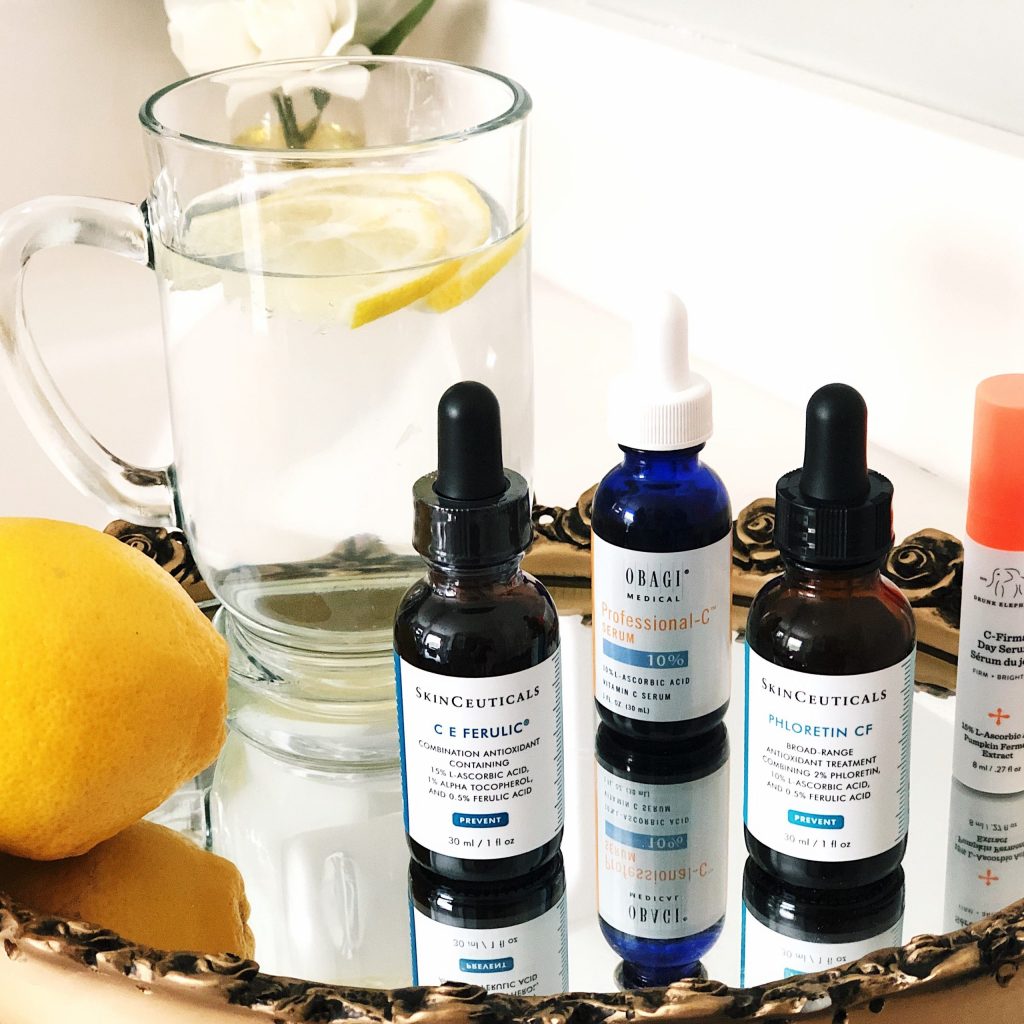Vitamin C is the most common antioxidant in skin. Unfortunately, humans do not have the enzyme (L-gluconogamma lactone oxidase) to make vitamin C, therefore it must be obtained from external sources.
L ascorbic acid is the active form of vitamin C that carries out the biologic effects. Besides retinoids, vitamin C is probably the next most studied ingredient in skincare. Ascorbic acid has many benefits. Repeat studies have shown it helps to prevent photodamage from UVA and UVB radiation. It stimulates collagen production, serving as co-factor for enzymes in collagen production. Lastly, vitamin C is a great lightening ingredient. It blocks tyrosinase, key enzyme in melanin production.
However, vitamin C is highly unstable. It easily oxidizes in light, heat, pH change, and presence of other other ions. This has led to development of various vitamin C derivatives that are more stable while trying to retain efficacy. However formulation continues to be a challenge. Demonstrating ingredient effectiveness needs to occur not just in the laboratory setting or on animals, it also needs assessment on human skin. Unfortunately, there’s a paucity of data regarding skincare ingredients in general (compared to medical dermatology), and some publications are conflicting. One study may show benefit of a derivative, while another demonstrates no efficacy. This inherently speaks to the challenges of manufacturing L ascorbic acid, as formulation is everything.
Review of vitamin C and derivatives

L-ascorbic acid

Active form of vitamin C (AA). The most studied form of vitamin C in literature.
Hydrophilic molecule
Optimal formulation:
pH: 3.5 or lower
Concentration: 15%. The optimal range is 10-20%; greater than 20% did not increase levels in skin.
When 15% is applied to skin, it saturates skin in 3 days, and decreases by 50% in 4 days. Once inside the skin, it cannot be removed by washing.
When combined with 1% vitamin E and 0.5% ferulic acid the stability and antioxidant effects increases by 8 fold.
Skinceuticals CE Ferulic serum by far has the most published studies of all vitamin C serums. Skinceuticals hold a patent (U.S. Patent No. 7,179,841) on this formulation, and since then many other dupes has developed on the market but do not contain the exact formulation and often lack clinical studies.
Sodium and Magnesium ascorbyl phosphate

Salt forms for L-ascorbic acid. Thus, effectiveness depends on skin conversion of SAP/MAP to AA.
Optimal formulation:
pH: 7
MAP has better stability in emulsion vehicle.
Studies on efficacy has been mixed. Few studies demonstrate issues with percutaneous absorption, while other in vivo and in vitro studies show benefit.
Since these are charged molecules, formulation at neutral pH to help with skin penetration is key.
Ascorbyl glucoside (AA-2G)

Glucose (sugar) group modified on AA for protect against photodegradation. AA-2G is converted to AA by skin enzyme α-glucosidase, giving more sustained release of vitamin C on skin. Further, its less irritating than AA.
Optimal formulation:
- pH 6.4
- Emulsion vehicle
AA-2G is only 50% as potent, compared to AA, as an antioxidant. But has comparable collagen stimulating and tyrosinase inhibiting properties.
3-O-ethyl ascorbic acid (3OAA)

Ethylated vitamin derivative. It’s stable in various temperatures and most commonly used in Asian skincare for brightening benefits.
Optimal Formulation:
- pH 5.46
Similar to AA-2G it is less effective compared to AA. It seems promising as an antioxidant and tyrosinase inhibitor, but studies are limited on its effect on neocollagenesis.
Ascorbyl palmitate

Lipophilic ester form of AA. Unfortunately due to its chemical structure, the stability is similar to AA and is one of the least stable vitamin C derivatives. However it has better skin penetration given its lipophilic nature
Optimal formulation:
- pH: neutral
- Variable depending on carrier system
- Gel-cream maybe best vehicle
It has demonstrated antioxidant and anti-aging benefits. However like MAP/SAP, there’s questionable conversion to AA in skin. Furthermore, one study has shown that ascorbyl palmitate when exposed to UVB may actually potentiate lipid oxidation, leading to more oxidative damage on skin.
Tetrahexyldecyl Ascorbate

Lipid soluble and stable form of pro vitamin C with enzymatic conversion to AA in skin. It has better skin penetration (4x compared to MAP). Given its lipophilic nature, it’s able to penetrate into dermis, where AA cannot. Smaller studies suggest it may potentially be more potent than AA and less irritating.
Optimal formulation:
- pH: 5.5-6.5
Ascorbyl Tetraisopalmitate (ATIP)

Similar to tetrahexyldecyl ascorbate, ATIP is another lipid soluble form of vitamin C with slight different chemical structure. In vitro studies have shown a conversion to AA at rate of 84%. It has great stability with a longer shelf-long of 6-12 months.
Optimal formulation:
- pH: 5.5-6.5

